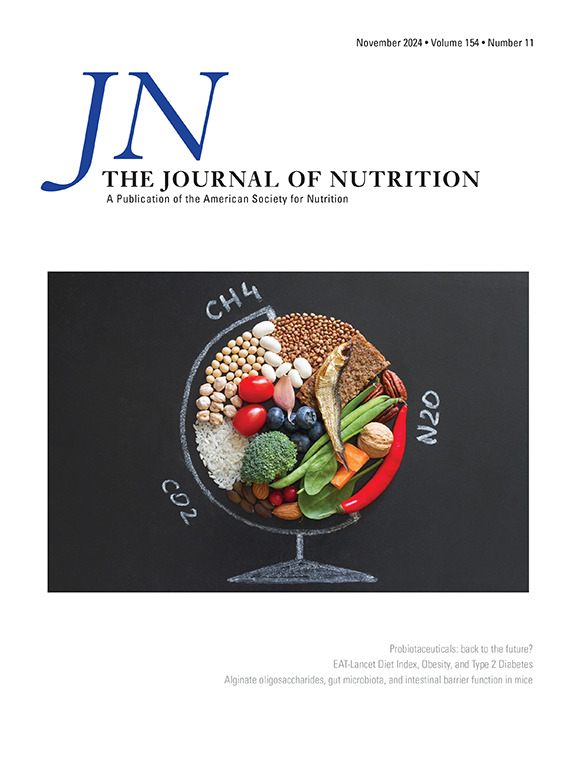The Concentration of Liver-Expressed Antimicrobial Peptide 2 in Human Milk and Infant Plasma Is Positively Associated with Adiposity and Body Weight in the First Year of Life
IF 3.7
3区 医学
Q2 NUTRITION & DIETETICS
引用次数: 0
Abstract
Background
The liver-expressed antimicrobial peptide 2 (LEAP2) is a recently recognized anorectic and glucose-regulating hormone with an unknown role in lactation.
Objectives
The objectives of this study were as follows: 1) to assess LEAP2 presence in human milk and putative associations with infant body weight and adiposity in the first year of life, 2) to evaluate the impact of maternal weight status on LEAP2 concentration, and 3) to explore the relationship between infant plasma LEAP2 concentration and body weight and adiposity.
Methods
This prospective cohort observational study assessed LEAP2 concentration in plasma and milk from lactating women with normal weight (n = 26) or overweight or obesity (OW/OB, n = 26) at 6 mo postpartum and in 6-mo-old infant plasma, examining associations with metabolic and anthropometric variables at 6 mo and 1 y. Maternal plasma and milk leptin and insulin concentrations were also measured. LEAP2 expression in milk fat globules and single-cell-RNA-sequencing datasets was evaluated.
Results
LEAP2 was detected in all milk samples assessed (2.08 ± 0.65 ng/mL) and was positively associated with infant triceps (P = 0.022, Cohen f2 = 1.25) and subscapular (P = 0.008, f2 = 0.68) skinfolds at 1 y old. Maternal LEAP2 was positively associated with insulin (P = 0.005, f2 = 0.30) and prepregnancy body mass index (BMI) (P = 0.040, f2 = 0.17) and negatively associated with gestational weight gain (P = 0.008, f2 = 0.25) and postpartum weight retention (P = 0.036, f2 = 0.15). Maternal LEAP2 was higher in plasma (P = 0.039), but not milk of lactating women with OW/OB. Infant plasma LEAP2 (1.98 ± 0.28 ng/mL) was positively associated with weight (P = 0.004, f2 = 0.63), BMI (P = 0.049, f2 = 0.37), and weight-for-length (P = 0.024, f2 = 0.35) z-scores at 1 y old, predominantly in males. No evidence for LEAP2 mRNA expression was found in mammary cells.
Conclusions
Milk LEAP2 is a bioactive component that plays a role in infant fat accretion in the first year of life. Although maternal LEAP2 responds to weight change in pregnancy and lactation, infant plasma LEAP2 might be involved in body weight regulation in early life.
This trial was registered at clinicaltrials.gov as NCT05798676.
母乳和婴儿血浆中 LEAP2 的浓度与婴儿出生后第一年的脂肪含量和体重呈正相关。
背景:肝脏表达的抗菌肽 2(LEAP2)是最近被确认的一种厌食和血糖调节激素,在哺乳期的作用尚不清楚:目的:1)评估母乳中 LEAP2 的含量以及它与婴儿出生后第一年体重和肥胖的关系;2)评估母亲体重状况对 LEAP2 浓度的影响;3)探讨婴儿血浆中 LEAP2 浓度与体重和肥胖的关系:这项前瞻性队列观察研究评估了体重正常(26 人)或超重/肥胖(OW/OB,26 人)的哺乳期妇女产后 6 个月时血浆和乳汁中的 LEAP2 浓度,以及 6 个月大婴儿血浆中的 LEAP2 浓度,并研究了 6 个月和 1 岁时与代谢和人体测量变量的关系。此外,还测定了母体血浆和乳汁中瘦素和胰岛素的浓度。评估了牛奶脂肪球和单细胞-RNA测序数据集中LEAP2的表达:所有被评估的牛奶样本中都检测到了 LEAP2(2.08±0.65 ng/ml),并且 LEAP2 与婴儿 1 岁时的肱三头肌(p=0.022,Cohen f2=1.25)和肩胛下(p=0.008,f2=0.68)皮褶呈正相关。母体 LEAP2 与胰岛素(p=0.005,f2=0.30)和孕前体重指数(BMI)(p=0.040,f2=0.17)呈正相关,与妊娠体重增加(p=0.008,f2=0.25)和产后体重保持(p=0.036,f2=0.15)呈负相关。患有卵巢早衰/卵巢早衰的哺乳期妇女血浆中的母体 LEAP2 含量较高(p=0.039),但乳汁中的 LEAP2 含量不高。婴儿血浆中的LEAP2(1.98±0.28纳克/毫升)与1岁时的体重(p=0.004,f2=0.63)、体重指数(p=0.049,f2=0.37)和体重身长(p=0.024,f2=0.35)z-评分呈正相关,主要是男性。在乳腺细胞中没有发现 LEAP2 mRNA 表达的证据:结论:牛奶中的 LEAP2 是一种生物活性成分,在婴儿出生后第一年的脂肪积累过程中发挥作用。结论:乳汁中的 LEAP2 是一种生物活性成分,在婴儿出生后第一年的脂肪增加过程中发挥作用。母体 LEAP2 对孕期和哺乳期的体重变化有反应,而婴儿血浆中的 LEAP2 可能参与了生命早期的体重调节:本研究在 clinicaltrials.gov 登记为 NCT05798676。https://clinicaltrials.gov/study/NCT05798676。
本文章由计算机程序翻译,如有差异,请以英文原文为准。
求助全文
约1分钟内获得全文
求助全文
来源期刊

Journal of Nutrition
医学-营养学
CiteScore
7.60
自引率
4.80%
发文量
260
审稿时长
39 days
期刊介绍:
The Journal of Nutrition (JN/J Nutr) publishes peer-reviewed original research papers covering all aspects of experimental nutrition in humans and other animal species; special articles such as reviews and biographies of prominent nutrition scientists; and issues, opinions, and commentaries on controversial issues in nutrition. Supplements are frequently published to provide extended discussion of topics of special interest.
 求助内容:
求助内容: 应助结果提醒方式:
应助结果提醒方式:


